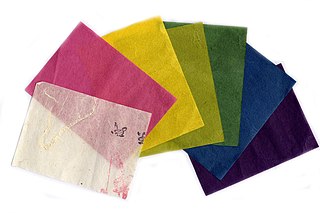 W
WThe traditional lighting equipment of Japan includes the andon (行灯), the bonbori (雪洞), the chōchin (提灯), and the tōrō (灯篭).
 W
WGenkō yōshi is a type of Japanese paper used for writing. It is printed with squares, typically 200 or 400 per sheet, each square designed to accommodate a single Japanese character or punctuation mark. Genkō yōshi may be used with any type of writing instrument, and with or without a shitajiki.
 W
WIno Paper Museum is a museum of Japanese paper in Ino, Kōchi Prefecture, Japan. It focuses on the production of Tosa Washi, dating back over a thousand years, and paper is also made by hand in a workshop on site.
 W
WIse katagami (伊勢型紙) is the Japanese craft of making paper stencils for dyeing textiles. It is designated one of the Important Intangible Cultural Properties of Japan. The art is traditionally centered on the city of Suzuka in Mie Prefecture. This is good for making a certain shape or picture within your project. It is different from Ise washi though both are made in Mie Prefecture.
 W
WIse washi (伊勢和紙) is a type of Japanese paper (washi) made in Ise, Mie Prefecture, Japan.
 W
WJapanese tissue is a thin, strong paper made from vegetable fibers. Japanese tissue may be made from one of three plants, the kōzo plant, the mitsumata shrub and the gampi tree. The long, strong fibers of the kōzo plant produce very strong, dimensionally stable papers, and are the most commonly used fibers in the making of Japanese paper (washi). Tissue made from kōzo, or kōzogami (楮紙), comes in varying thicknesses and colors, and is an ideal paper to use in the mending of books. The majority of mending tissues are made from kōzo fibers, though mitsumata and gampi papers also are used.
 W
WWashi (和紙) is traditional Japanese paper. The word "washi" comes from Wa meaning 'Japanese' and shi meaning 'paper'. The term is used to describe paper that uses local fiber, processed by hand and made in the traditional manner. Washi is made using fibers from the inner bark of the gampi tree, the mitsumata shrub, or the paper mulberry (kōzo) bush. As a Japanese craft, it is registered as a UNESCO intangible cultural heritage.
 W
WOrigami paper is used to fold origami, the art of paper folding. The only real requirement of the folding medium is that it must be able to hold a crease, but should ideally also be thinner than regular paper for convenience when multiple folds over the same small paper area are required.
 W
WA handheld fan, or simply hand fan, may be any broad, flat surface that is waved back-and-forth to create an airflow. Generally, purpose-made handheld fans are folding fans, which are shaped like a sector of a circle and made of a thin material mounted on slats which revolve around a pivot so that it can be closed when not in use.
 W
WWashi (和紙) is traditional Japanese paper. The word "washi" comes from Wa meaning 'Japanese' and shi meaning 'paper'. The term is used to describe paper that uses local fiber, processed by hand and made in the traditional manner. Washi is made using fibers from the inner bark of the gampi tree, the mitsumata shrub, or the paper mulberry (kōzo) bush. As a Japanese craft, it is registered as a UNESCO intangible cultural heritage.